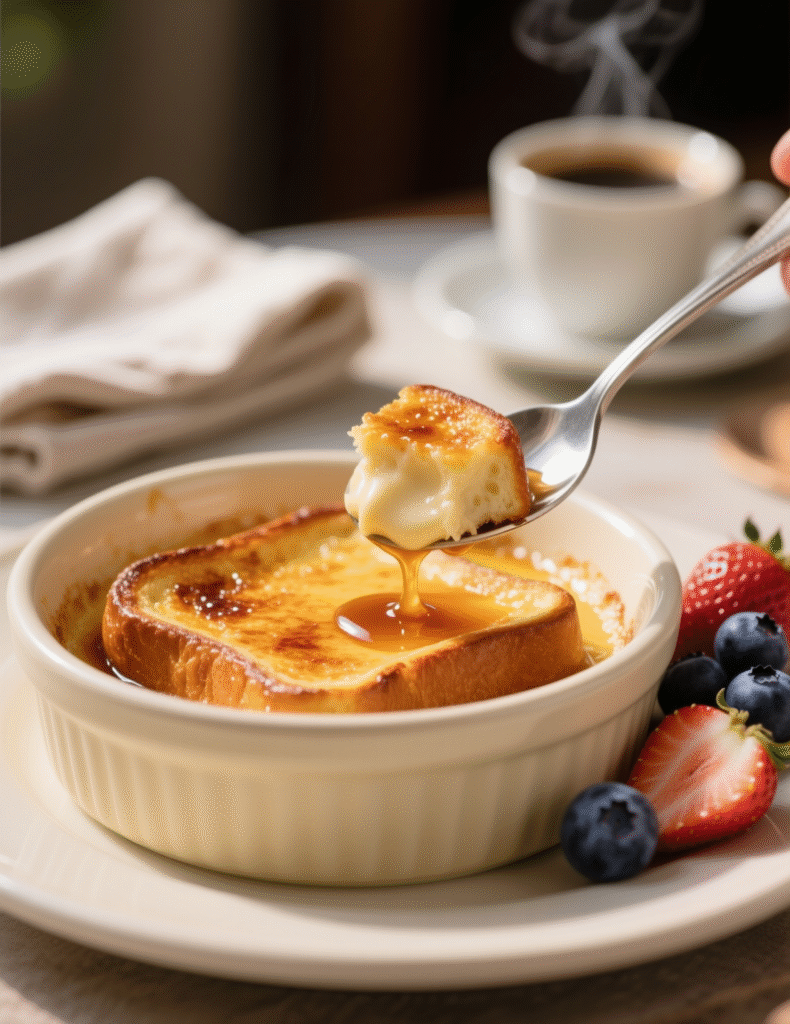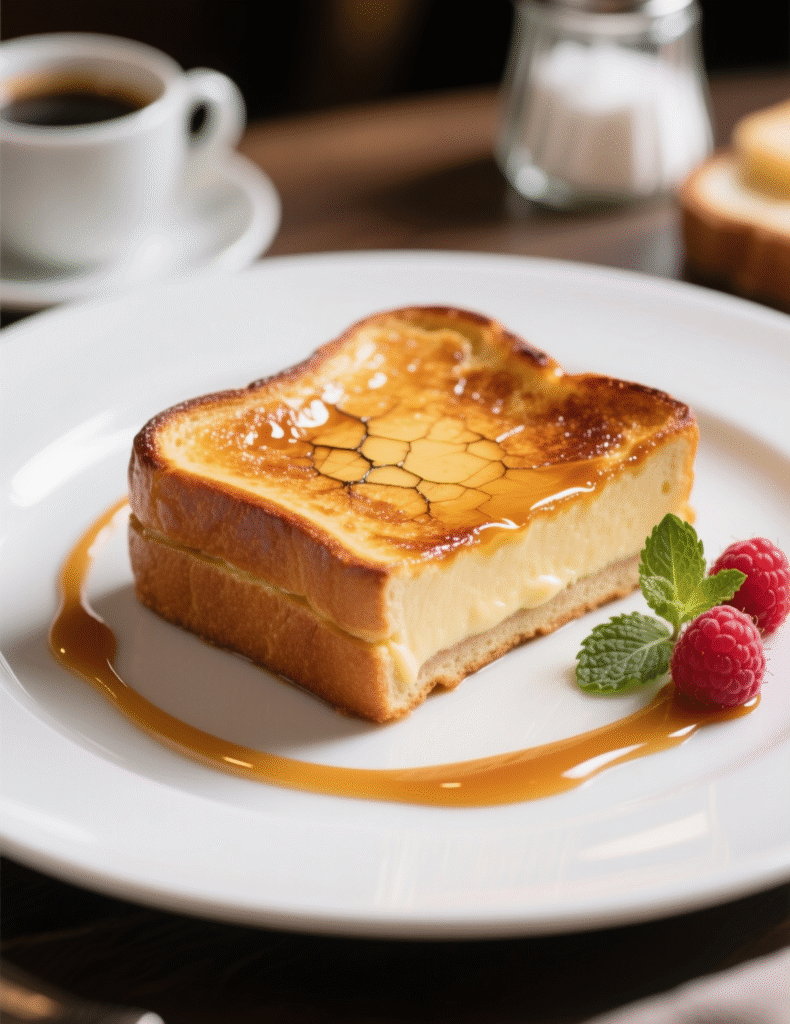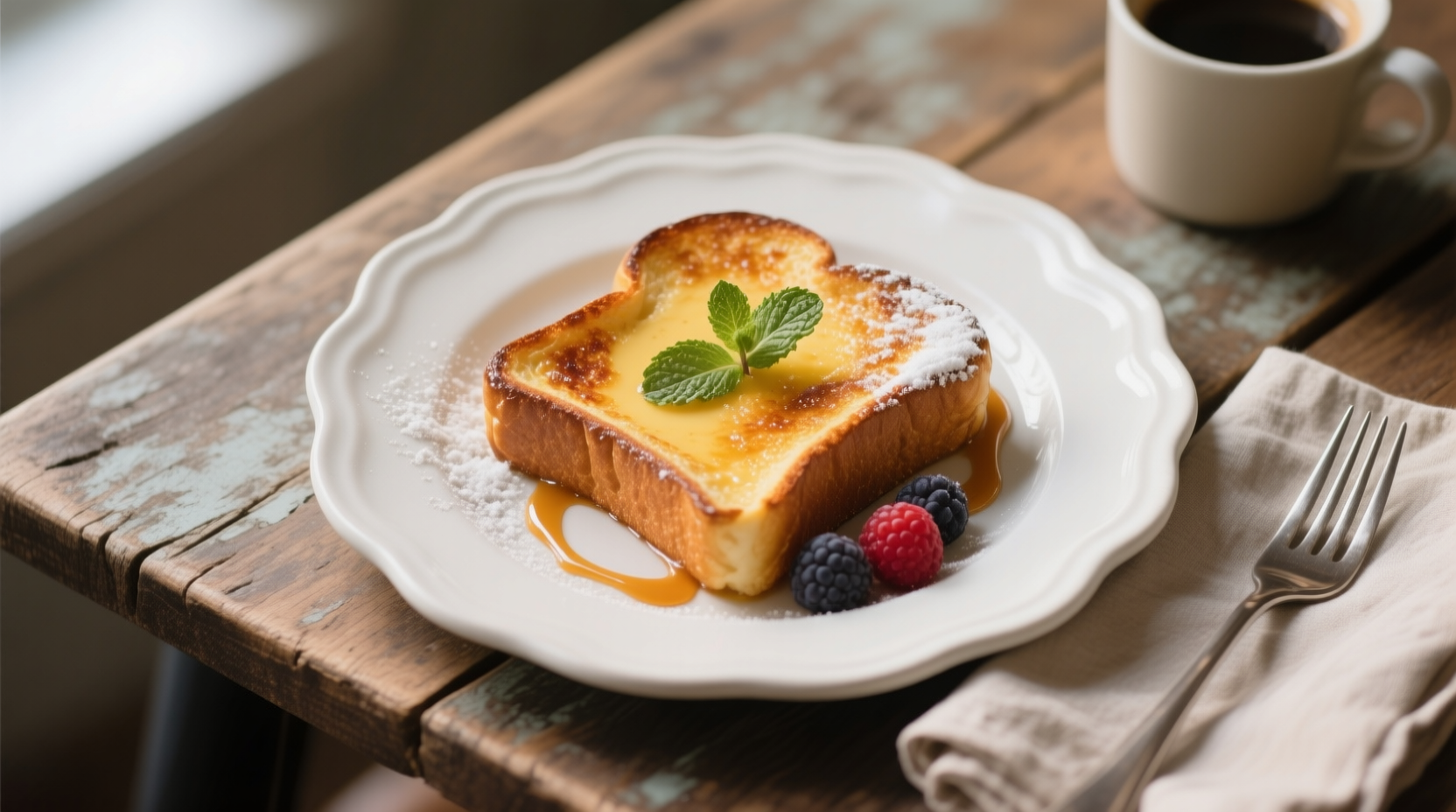There’s something magical about waking up to a dish that’s already waiting for you, golden and bubbling at the edges, the scent of caramelized sugar sneaking into every corner of the kitchen. Overnight crème brûlée French toast isn’t just breakfast—it’s pastry technique meeting comfort food, a kind of cross between a custard dessert and a bakery loaf. Professional chefs know this dish well, because it brings together principles of custard science, bread hydration, sugar crystallization, and controlled caramelization. In other words: simple for the diner, complex for the maker.
Why Overnight Matters
Bread is not just bread when it comes to this recipe. The overnight rest is not optional—it’s the engine of the whole vehicle. During those hours, the custard base seeps through the porous structure of the loaf, binding starches and proteins together, creating something that’s neither cake nor pudding. Skip the overnight part and you’ll have soggy toast on the edges with a dry center. Professionals know hydration is time-dependent, not force-dependent. No amount of “quick soak” hacks will match a slow, even absorption overnight.
The Science of the Custard
At its core, crème brûlée French toast relies on custard science: the dance of egg proteins with dairy fat and sugar. A standard custard ratio is about 1 egg per ½ cup of liquid, but here the bread acts as a sponge, demanding slightly higher egg density for structure. A pro will often add heavy cream for richness and balance it with whole milk to avoid overcoagulation. Too much cream and you risk greasy pockets; too little and you lose the silkiness that sets this dish apart.
Vanilla is classic, but vanilla alone is predictable. I’ve seen chefs infuse the custard with earl grey tea, tonka beans, or even a splash of bourbon. The custard will carry those notes quietly, not loud, like a well-trained orchestra behind a soloist.
Bread: The Structural Backbone
Choosing bread isn’t guesswork. Brioche and challah dominate for a reason: high egg and butter content creates a soft, enriched crumb that drinks up custard without collapsing. Sourdough, with its tang, works too if you want contrast. The key is staleness. A fresh loaf collapses into mush; a 2-day-old loaf provides structure. I tell young cooks: if you wouldn’t toast it dry for a sandwich, don’t use it here.
Thickness matters. Slices about 1 to 1½ inches are ideal. Thin slices disintegrate; thick slabs resist custard penetration. Geometry here decides the final texture.
Caramel: The Brûlée Element
The “brûlée” part of this dish isn’t metaphor—it’s literal caramelization. Professionals know caramel is unforgiving. You heat sugar too fast and it crystallizes, too slow and it becomes bitter. The right method: melt butter, stir in brown sugar until it becomes glossy, then spread evenly at the bottom of the baking dish. This forms the foundation—an upside-down caramel crust.
During baking, the sugar liquefies again, merges with butter, and creates that glassy, shattering crust once flipped. Some chefs cheat with a blowtorch after baking, dusting extra sugar and brûléeing directly. It’s flashy for brunch service, but at home, the built-in caramel base is enough.

Method: Professional Breakdown
- Prepare the Caramel Base
Melt unsalted butter with light brown sugar until smooth. Pour it into the bottom of a buttered casserole dish, tilting to coat. This becomes your crust. - Slice the Bread
Arrange slices of day-old brioche tightly, no gaps. Gaps mean uneven soaking, and uneven soaking means complaints later. - Mix the Custard
Whisk eggs, heavy cream, whole milk, vanilla extract, a pinch of salt, and a dusting of nutmeg. Strain through a fine sieve if you want the silkiest finish—tiny chalazae strands can ruin texture. - Soak Overnight
Pour custard evenly over bread. Press down lightly to ensure contact. Cover and refrigerate at least 8 hours, preferably 12. - Bake
Bake at 350°F (175°C) uncovered for 40–50 minutes, until puffed and golden. Internal temperature should reach 170°F for custard set. - Serve
Let rest 10 minutes before inverting onto a platter. The caramel should drip and coat the slices like a glaze.
Professional Tips for Perfection
- Temperature Control: A water bath is optional but provides insurance. In professional kitchens, custards are rarely baked without it. A bain-marie moderates oven heat and prevents curdling.
- Flavor Balancing: Sugar content must be adjusted depending on bread type. Brioche already leans sweet; sourdough may need more caramel.
- Service Style: Restaurants often portion before baking for cleaner plating. At home, the large casserole is more communal.
- Garnishes: Fresh berries cut through richness. A drizzle of crème anglaise or fruit coulis elevates it into dessert territory.
Nutritional and Menu Context
This dish is not light, and pretending it is would be dishonest. A single portion easily carries 350–450 calories, most from fat and sugar. But in a professional menu, it has its place—special occasions, Sunday brunch, or as a crossover dessert. Some chefs have leaned into the decadence, pairing it with espresso ice cream or salted caramel drizzle.
According to National Restaurant Association brunch trend reports, custard-based baked French toasts have risen in popularity since 2019, often as “Instagram dishes.” Diners love caramelized crusts that crack under the spoon—it’s sensory theater.
Common Mistakes and Fixes
- Custard Breaking: If the custard looks scrambled, the oven was too hot or uneven. Solution: water bath or tent with foil mid-bake.
- Soggy Bottom: Too much liquid relative to bread volume. Fix by measuring carefully—roughly 2 cups of custard per 8 slices.
- Overly Dense Texture: Using bread that’s too fresh. Always stale or toast the slices lightly.
Emerging Variations
The classic vanilla-bourbon base is being reimagined in many kitchens. Matcha crème brûlée French toast appeared in Tokyo cafes. In Paris, some chefs lace the custard with pistachio paste. Plant-based adaptations use coconut cream and aquafaba, though the mouthfeel isn’t identical. The point: the method is stable, but flavor profiles are endlessly adaptable.
Case Study: Hotel Brunch Program
A luxury hotel in New York added crème brûlée French toast to its buffet in 2022. Within six months, it became the second most-ordered item after omelets. Their method? Individual ramekins baked in a water bath, brûlée torched tableside. Guests described it as “breakfast theater.” The lesson: presentation amplifies perceived value, even if the recipe is simple.
Expert Insight: Custard as Memory Food
Chefs often talk about food as memory. Custards, in particular, carry nostalgia. Crème brûlée French toast borrows from both breakfast comfort and fine-dining desserts. That’s why it works so well. It makes a diner feel like a child and an adult at once. Professionals designing menus know emotional impact is as important as flavor.

Practical Applications for Professionals
- Catering: Scales well in large pans. Can be baked ahead and reheated gently.
- Restaurants: Adaptable for à la carte plating with torch finish.
- Home Cooks: Accessible without specialty tools, yet impressive enough for holidays.
Conclusion
Overnight crème brûlée French toast is more than just an indulgent breakfast—it’s a lesson in how time, technique, and ingredient balance turn humble bread and eggs into a luxurious dish. The overnight soak transforms texture, the caramel base creates drama, and the custard science ensures consistency. For professionals, it’s a versatile recipe adaptable for buffets, plated service, or family-style dining. For enthusiasts, it’s a reminder that patience in the kitchen often rewards more than shortcuts ever will.
Serve it once, and you’ll see: the caramelized crust crackles under the knife, the custard middle trembles softly, and people at the table stop talking for a moment. That pause, that silence, is the mark of a dish done right.
FAQs
What makes overnight crème brûlée French toast different from regular French toast?
It uses an overnight custard soak and caramel base, giving it a pudding-like texture with a brûléed crust.
Can I use fresh bread instead of stale bread?
No, fresh bread will collapse—day-old or lightly toasted bread is best.
Do I need a water bath to bake it?
Not strictly, but a water bath helps prevent curdling and ensures even baking.
How long should it soak overnight?
At least 8 hours, though 12 hours gives the best absorption and texture.
What bread works best for this recipe?
Brioche and challah are ideal, but sourdough works for a tangier twist.
Can I prepare it ahead for a party?
Yes, assemble the night before and bake fresh before serving.
Is torching the top necessary for the brûlée effect?
No, the caramel base creates the crust, but torching adds dramatic presentation.
How do I avoid a soggy bottom layer?
Measure custard properly and use sturdy, stale bread to absorb it evenly.
Can I make it less sweet?
Yes, reduce sugar in the custard or caramel, and balance with fresh fruit toppings.
What’s the ideal oven temperature?
Bake at 350°F (175°C) until puffed, golden, and custard reaches 170°F internally.

Mariana is a passionate home cook who creates delicious, easy-to-follow recipes for busy people. From energizing breakfasts to satisfying dinners and indulgent desserts, her dishes are designed to fuel both your body and hustle.
When she’s not in the kitchen, she’s exploring new flavors and dreaming up her next recipe to share with the Foodie Hustle community.

